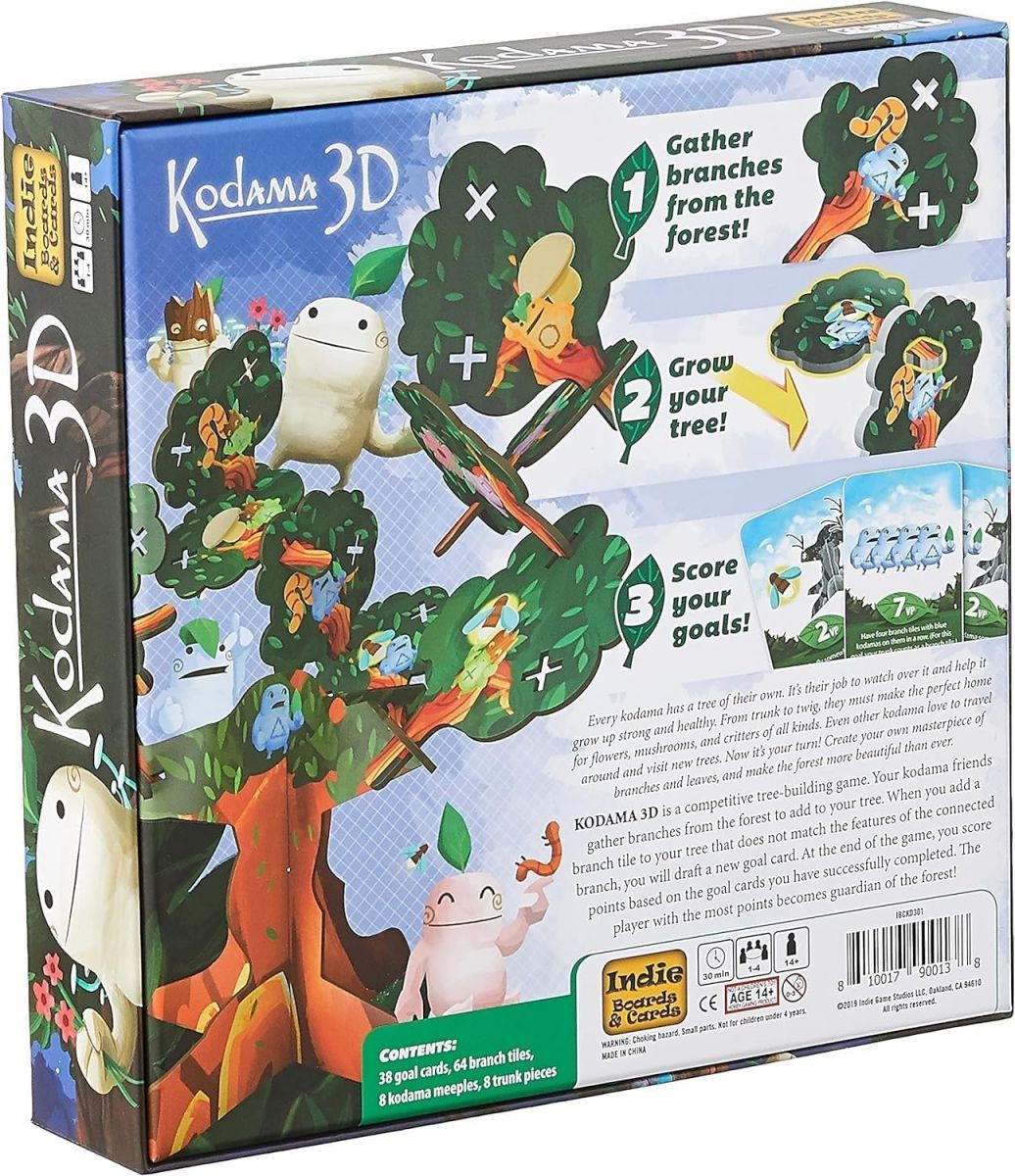Grow a Tree in Kodama 3D!

Create a beautiful tree for your Kodama, a tree spirit; fill it with his friends, flowers, mushrooms, and caterpillars, and watch it come to life!
Published by Indie Boards & Cards, Kodama 3D is a reimagining of the tile-laying card game Kodama: The Tree Spirits, and is designed for 1-4 players.
Gameplay
Each player takes a tree trunk, which has three different sides you can connect to. Each player also starts the game with two scoring cards in hand. You make stacks of tree branch tiles and place them in a grid in the center of the table. The number in each stack and the size of the grid varies based on player count. Each player takes two little Kodama meeples in their player color and takes turns placing them. When it is your turn to place a meeple, you may place it on any stack that does not already have a meeple on it.
On your turn, you move one of your meeples in a straight line in the grid (horizontally, vertically, or diagonally), stopping at any unoccupied stack. You cannot pass over another meeple. You then take the top branch tile from the stack your meeple just left and add it to your tree. In addition to the three connection points on your tree trunk, each branch also has two potential connection points.
Each branch has one of four features (caterpillar, firefly, flower, or mushroom) and a Kodama in one of four colors. If, when you play a branch, you do not connect it to a branch with either a matching Kodama or feature, then you get to take a new scoring card, either one of four face-up in the display, or the one on top of the draw deck. It is now the next player’s turn.
Play continues like this until everyone has ten branches on their trees. You then take the top branch tile that is beneath both of your meeples, add them to your tree, and then score your score cards. Scoring cards typically require you to have a certain number of branches connected in a continuous line that have the same color Kodama or feature in order to score points. Or they might, for example, score a number of points for each copy of a specific feature that you have a certain distance from the trunk of your tree. The player with the most points wins.

Review
Kodama 3D is aesthetically lovely, has a great table presence, and a scoring system that doesn’t make things too complicated. All the score cards are pretty intuitive and there’s a nice wide range of them as well, and balancing when to draw a new one and when to focus on meeting the requirements of the ones already in your hand, leads to some good choices. It’s also helpful to collect scoring cards that complement each other.
The 3D nature of the game serves both the theme and the mechanics well. It’s satisfying to build your tree and watch it branch out, and given that each branch can split off into two directions, it’s actually an easier way to build the tree and keep it organized than if you were just laying cards or tiles off of each other. We found the branches slid fairly well into the connectors, although there is some concern about wear and tear over time.
There is a lot of setup the first time you play, as you have to individually punch out a bit of cardboard at every connection point (or at least do it each time you draft a branch tile for the first time — either way it’s a bit annoying), but that’s a limited-time nuisance. The game could also use a round tracker. We found ourselves having to count, multiple times, how many branches were on each tree. The round is especially important in this game, given the importance of planning one or two turns ahead.
The rules are light, and there’s not a lot of player interaction outside of blocking each other on the grid, but it’s not easy to really track what other players have happening on their trees. You might remember what score cards they’re collecting, and remember they might want mushrooms, for example, but in general you’re just trying to maximize the points on your own tree.
Kodama 3D is a satisfying game that uses its 3D mechanics quite well. The little creatures are cute, and it’s surprisingly easy to read your tree and check your points at the end of the game.
Pros: The 3D aspect of the game serves it well, components are attractive and tree is easy to build, scoring system works well
Cons: Potential wear and tear issues over time, no round tracker, not a lot of direct player interaction
Disclosure: we received a complimentary review copy of this game.







